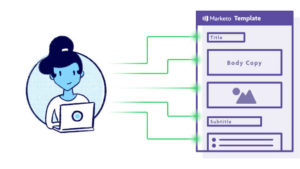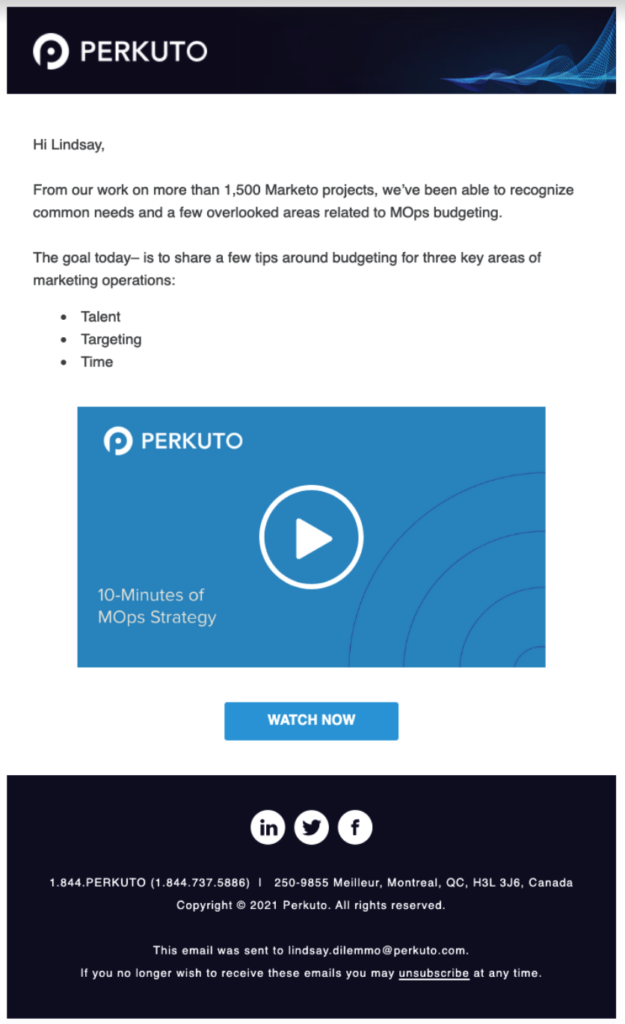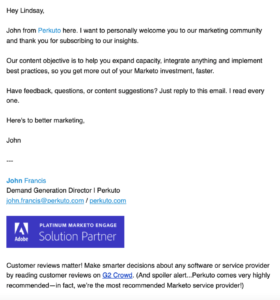Strategy should drive technology, not the other way around.
– Darrell Alfonso, Global Marketing Operations at AWS
We couldn’t agree more.
According to Harvard Business Review, most people make this mistake because they take a bottom up approach to MarTech, one where they focus on what a technology is able to do, rather than the objective they are trying to achieve.
Instead, you should be asking yourself: what objectives do you need to meet, and how can you leverage technology to make that possible?
If you work with a marketing automation platform, this scenario may sound familiar:
Your team has made a large investment in a marketing automation platform, yet after a couple months, you’re still not seeing your full investment come to fruition. This can be attributed to the following factors:
- Complexity: The platform is more complex than your team anticipated, which means you can only allow trained users in Marketo.
- Bandwidth: Campaign creation is eating away at your time, which has significantly reduced your bandwidth to work on high-impact projects and strategic initiatives.
Instead of using the platform to take your marketing operations strategy to the next level, you’re spending most of your time bogged down by the manual aspects of campaign creation and chasing down missing information.
This is a classic example of technology driving strategy.
With campaign requests piling up and only trained users in Marketo able to make changes, you’ve pushed strategy aside and you’re solely focused on staying afloat. You know it’s too risky to allow untrained users in your MAP, which means all requests fall on you.
It was recognizing this issue that our team built Jeto. From a strategic perspective, it’s important to empower anyone to self-serve Marketo campaigns.
The Full Potential of the Marketo Token
Building a strong Marketo token strategy is key to scaling up in marketing operations. Campaign execution can go a lot faster when you employ a system of cascading inherited tokens, allowing you to quickly update content across multiple assets.
(You’ll still need to start with a strong token strategy in order to take advantage of automation. We recommend this article (see step two) if you don’t have that in place yet.)
Asking an untrained user to leverage tokens in this way can be kind of tricky. So you, as the expert, will often be delegated with that task. And even then, updating tokens can be a repetitive (and boring) task.
Enter Jeto.
Our platform acts as a “user-friendly layer” between users and your Marketo instance. Jeto’s form fields map to tokens inside Marketo so that it’s faster and easier to update programs – whether you’re a novice or a seasoned expert.
Check out this video demonstrating how quickly Jeto form field entries get passed into a completed program with tokens filled:
Tokens are useful for a wide range of Marketo functions, making Jeto an extremely versatile tool.
Jeto’s Common (and Secret) Use Cases
Jeto might be best known for reducing grunt work and streamlining communications around Marketo campaigns, but there are some use cases you might not be aware of.
That’s what Allie van Aken, Marketing Automation Campaign Operations Manager at Poly, realized when her team was looking for ways to meet excess demand.
“We started to think creatively on how we could leverage Jeto to fill our resource gap, and we realized it’s actually quite a flexible tool.”
Take a look at our use cases below, where you can gain inspiration on how to best leverage Jeto.
Self-serve marketing campaigns
The most common way clients use Jeto is to enable anyone on their team (especially untrained marketers) to self-serve Marketo campaigns.
We do this by offering a user-friendly interface, where it’s easy to upload images, fill in token values, preview emails and landing pages, and send samples.
Once a marketer is satisfied with the campaign, they hit submit. From here, Jeto automatically generates the completed program following the proper naming convention in the correct folder.
Not only does this create autonomy across your team, it also significantly cuts down on time. Our client Poly was able to decrease campaign turnaround time by up to 60 percent.
“With Jeto, I just fill in form fields, then the program gets cloned, following proper naming conventions, and turns on all the campaigns for me.” Allie van Aken, Marketing Automation Campaign Operations Manager at Poly
💡 Learn more on how Poly utilized Jeto to meet their goals.

Orchestrate campaign ops across your stack
With Jeto’s API now available, users are able to connect other tools to create a more seamless and efficient campaign execution process. Some of the most popular tools that clients are connecting are project management tools (Asana, Monday.com, Jira) and CRMs (Salesforce).
This enables you to kickoff campaigns from your project management tool or even automatically generate an SFDC campaign alongside a Marketo program.
The sky’s the limit when it comes to the tools you can integrate.
Speed up multi-email sequence creation
Does your organization send email sequences for white papers, blogs, or any other piece of content? Jeto allows your team to build static email sequences.
💡 Did you know? Through Jeto, our client was able to send a 54 email sequence in just two days.
See how Perkuto used Jeto to create their email sequence program, where they send one email per month to users who sign up for their 10-Minutes of MOps Strategy Video series.

Once a user signs up for the content series, they will also receive a welcome email from Perkuto’s Director of Demand Generation, John Francis.

Ready to elevate your strategy? Book a demo to see Jeto in action.
Distributed marketing efforts
Many of our clients work with distributed teams that manage their own promotions and communications. These distributed teams can be regional offices, faculties or departments in education, franchises, or dealerships to name a few.
Jeto reduces the lift from your Marketo admin by delegating the creation of assets, smart campaigns, updates, and more. Not only does this cut down on back-and-forth communication, it also allows for increased capacity on campaign execution.
This was the case for one of our clients, a higher education institution who used Jeto to reach students. Since each department had their own audience, Jeto allowed departments to manage communications with their own branding and audience list. This means more autonomy and less time on back-and-forths.
Simplify internal communications
Jeto isn’t just for external-facing communications! It’s an excellent tool for simplifying communications within your organization.
Does your HR team need to send company-wide emails? Whether it’s sharing updates on company policies, onboarding information for new employees, or invitations to company-wide celebrations, Jeto allows your HR team to easily send emails to your organization. If your product team regularly updates your organization on new features, they could also utilize Jeto.
Individual teams can send their own maintenance notifications, removing the Marketo admin as the middle man.
Elevate your sales communications
Widen the breadth of initiatives your sales team can create by giving them access to Jeto.
A few ways sales can leverage Jeto:
- Build customized landing pages for prospects
- Build out event programs for sales events
- Send SMS reminders for demos and renewals
💡 Learn how our client, Intimo, used Jeto to empower their team of non-technical sales specialists to seamlessly build marketing campaigns without ever stepping foot in Marketo. Read more.
Distribute event communications
Does your organization host events?
Through Jeto, your marketing team can allow individual speakers or teams to communicate with session attendees. This way, they can manage their own workflow and publishing schedule without needing the assistance of a Marketo admin to project manage and execute their communications.
For example, our client Mendix hosts a virtual event every year. With over 18,000 registrants for their 2021 virtual event, it was crucial to allow each department to own communications for their respective sessions. This removed the lift from their MOps team, and allowed teams to gain control of their communications.

